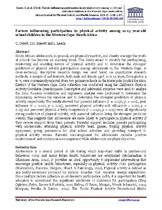| dc.description.abstract | South African adolescents, in general, are physically inactive, and obesity amongst the youth at schools has become an alarming trend. This study aimed to identify the predisposing, reinforcing and enabling factors of physical activity and to determine the strongest predictors of physical activity participation among adolescents in the Western Cape. A cross-sectional, descriptive research design was used based on quantitative research methods. A sample of 348 learners, both male and female aged 11 to 13 years, from grades 4 to 7, were conveniently selected from two primary schools in the Metropole South Education District of the Western Cape. Data collection was conducted using the Children’s Physical Activity Correlates Questionnaire. Descriptive and inferential statistics were used to analyse the data. Pearson correlation and regression analysis were performed to determine the relationship between the variables and to determine the strongest predictors of physical activity, respectively. The results showed that parental influence (r = 0.236, p < 0.01), peer influence (r = 0.012, p < 0.05), perceived physical activity self- efficacy (r = 0.212, p < 0.05) and perceived physical activity competence (r = 0.192, p < 0.05) were all significantly strong predictors of physical activity, with parental influence being the strongest predictor overall. This suggests that adolescents are more likely to participate in physical activity if they receive support from their parents. Parental support includes parents participating with adolescents, attending physical activity team games, buying physical activity equipment, giving permission for after school activities and providing transport to physical activity venues. Parental encouragement for adolescents includes positive reinforcement and continuous encouragement while adolescents are physically active. | en_US |

